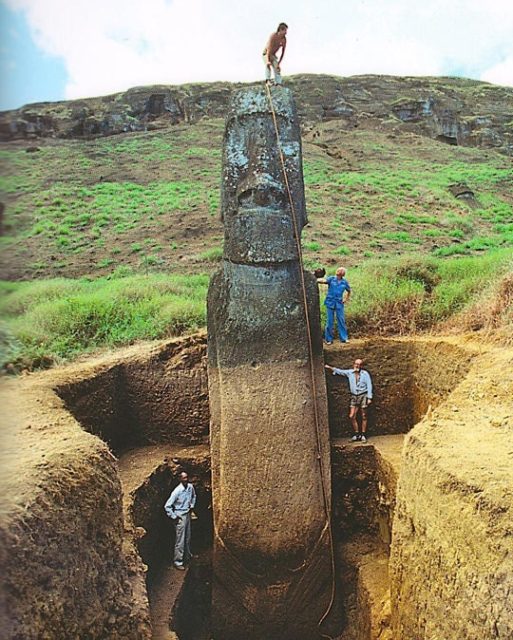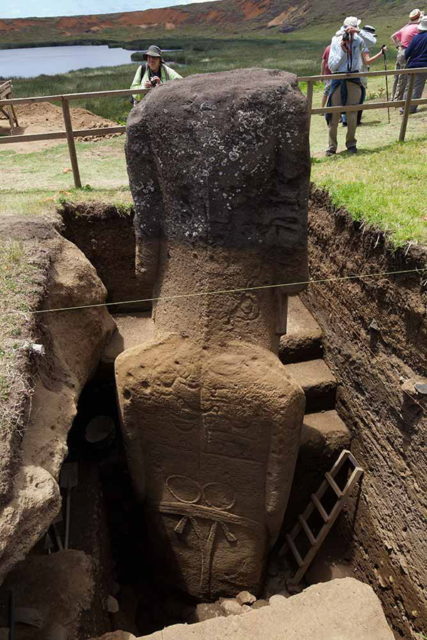Along the south-east coast of the island of Rapa Nui stand thirteen-foot statues representing the spirits of the leaders of the Rapanui, the native islanders of what we call Easter Island.
The most remote inhabited island on earth, Rapa Nui is located about 1,289 miles away from Pitcairn Island in the southeast Pacific Ocean. Mostly, people of Polynesian descent inhabit the island.

The statues, or Moai as they were named by the Islanders, were crafted from volcanic rock. The sculptors poured water on the volcanic rock in order to soften it while they carved.
It took a team of five or six sculptors about a year to complete each statue. Most of them remain in the quarry where they were created, but many were erected along the coast, and some are found peppering the interior of the island.
The statues, weighing in at about 18 tons, appear to have been transported by the natives to different parts of the island.
The Easter Island heads are frequently photographed and have been studied over the years since European explorers first observed them in 1722.
In one of the earliest excavations in 1914, it was discovered that the statue heads were attached to torsos hidden underground due to natural erosion of the island – over the centuries, landslides had covered them.
This information was not widespread, which led the public to believe the heads and shoulders that were exposed constituted the entire statue.
Archaeologist Jo Anne Van Tilburg, a research associate at the UCLA Cotsen Institute of Archaeology and director of its Rock Art Archive, has been lecturing and writing about the statues for many years. In 1998, Van Tilburg initiated the Easter Island Statue Project with residents of the island in order to locate and document each statue with the most modern equipment available.
When she posted photos of entirely excavated statues on the EISP website, it received so much attention the website crashed. “I was completely blindsided,” said Van Tilburg. “But now I quite understand it, because most of the photographs that are widely available on the Internet, and certainly in books, deal only with the very photogenic statues that are located on the slopes of the quarry in which they were carved… [they] do appear to be heads only. And, indeed, over the years, the statues were usually referred to as the Easter Island heads…now people are aware they have bodies. I think that’s fabulous. I love it when good science can be turned into public information so quickly.”

“What we found underneath the base of one of the statues was a signature stone, a basalt rock with an incised drawing of a crescent, or canoe motif” she said, “Over time, it seems, more of these canoes were etched onto the statue in a constant repetition of identity reasserting who they were. As the community lost a sense of identity over time, perhaps they wanted to mark these statues as their own,” she supposed.
How the islanders moved the giant moai is still a mystery. Some scientists believe the statues were “walked “ to their destination, as legend has said.
Ropes could have been tied to the figure, and each corner moved forward one at a time. Because the heads of the moai found in the quarry are sloped downward while the heads of the transported figures are not, this could have been a factor in the center of gravity of the stone.
Additionally, the relocated stones have larger bases with fractures along the edges. Some statues were broken during transport and found along the road lying on their backs on an uphill grade. These aspects tend to indicate upright transport.
Another possible method involved a miro manga erua, a Y-shaped sled on which the statue was placed face down and tied with ropes around the neck, near the middle and at the bottom.

In 1998, Van Tilburg’s team attempted to move a replica of one of the statues in this fashion. It took 60 men to pull the sled carrying the replica 100 meters and Van Tilburg believes this was the preferred mode of transport.
On Van Tilburg’s list of conclusions regarding the experiment she states, “For us, some mysteries remain, although for today’s Rapa Nui people, they have never been in question.”
“It wasn’t done the way these archaeologists did it here,” explained a young Rapa Nui tour guide to a group of Japanese tourists. They stood puzzling at the spectacle of a concrete replica moai whose pukao has now fallen off, leaving a red gash on its perfectly shaped nose. “We believe the moai were moved by ‘mana.’ They walked across the land and our ancestors have celebrated it for centuries.”
